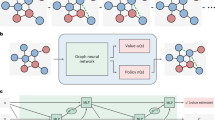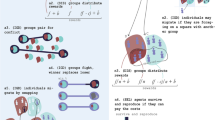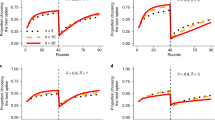Abstract
This study extends previous research that showed how informal social sanctions can backfire when members prefer friendship over enforcement of group norms. We use a type of neural network to model the coordination of informal social control in a small group of adaptive agents confronted with a social dilemma. This model incorporates two mechanisms of social influence, informal sanctions and imitation. Both mechanisms vary with the strength of the social tie between source and target. Previous research focused on the effects of social sanctions. Here, we demonstrate a curvilinear effect of imitation on compliance with prosocial norms. Moderate doses of imitation reduce the coordination complexity of self-organized collective action and help the network achieve satisfactory levels of cooperation. High doses, however, undermine the agent-based learning required to find cooperative solutions. Increasing group size also diminishes compliance due to increased complexity, with larger groups requiring more imitation to overcome the coordination problem.
Similar content being viewed by others
References
Axelrod, R. (1997), "The Dissemination of Culture: A Model with Local Convergence and Global Polarization," Journal of Conflict Resolution, 41, 203–226.
Blau, P.M. (1977), Inequality and Heterogeneity: A Primitive Theory of Social Structure. New York: Free Press.
Blau, P.M. and J. Schwartz (1984), Crosscutting Social Circles: Testing a Macrostructural Theory of Intergroup Relations. New York, NY: Academic Press.
Byrne, D.E. (1971), The Attraction Paradigm. New York, NY: Academic Press.
Byrne, D.E. and W. Griffit (1966), "ADevelopmental Investigation of the Lawof Attraction," Journal of Personality and Social Psychology, 4, 699–702.
Carley, K. (1991), "A Theory of Group Stability," American Sociological Review, 56, 331–354.
Cartwright, D. and F. Harary (1966), "Structural Balance: A Generalization of Heider's Theory," Psychological Review, 63, 277–293.
Churchland, P.S. and T.J. Sejnowski (1994), The Computational Brain. Cambridge, MA: MIT Press.
Cohen, J.M. (1977), "Sources of Peer Group Homogeneity," Sociology of Education, 50, 227–241.
Coleman, J.S. (1990), Foundations of Social Theory. Cambridge, MA: Harvard University Press.
Dawes, R.M. (1980), "Social Dilemmas," Annual Review of Sociology, 31, 169–193.
Festinger, L., S. Schachter and K. Back (1950), Social Pressures in Informal Groups. New York, NY: Harper.
Flache, A. (1996), The Double Edge of Networks. Amsterdam: Thesis Publishers.
Flache, A. and M.W. Macy (1996), "The Weakness of Strong Ties: Collective Action Failure in a Highly Cohesive Group," Journal of Mathematical Sociology, 21.
Hebb, D.O. (1949), The Organisation of Behavior: A Neuropsychological Approach. New York, NY: John Wiley and Sons.
Heckathorn, D.D. (1988), "Collective Sanctions and the Creation of Prisoner's Dilemma Norms," American Journal of Sociology, 94, 535–562.
Heider, F. (1958), The Psychology of Interpersonal Relations. New York, NY: John Wiley and Sons.
Homans, G.C. (1951), The Human Group. New York, NY: Harcourt Brace.
Homans, G.C. (1974), Social Behavior: Its Elementary Forms. New York, NY: Harcourt Brace Jovanovich.
Hopfield, J.J. (1982), "Neural Networks and Physical Systems with Emergent Collective Computational Abilities," Proceedings of the American Academy of Sciences, Vol. 79, pp. 2554–2558.
Hopfield, J.J. (1984), "Neurons with Graded Response have Collective Computational Properties like those of Two-State Neurons," Proceedings of the American Academy of Sciences, Vol. 81, pp. 3088–3092.
Hopfield, J.J. and D.W. Tank (1985), "'Neural' Computation of Decisions in Optimization Problems," Biological Cybernetics, 52, 141–152.
Kandel, D.B. (1978), "Homophily, Selection, and Socialization in Adolescent Friendships," American Journal of Sociology, 84, 427–436.
Lott, A.J. and B.E. Lott (1965), "Group Cohesiveness as Interpersonal Attraction: A Review of Relationships with Antecedent and Consequent Variables," Psychological Bulletin, 64, 259–309.
Macleod, J. (1995), Ain't No Makin It: Aspirations and Attainment in a Low Income Neighborhood. Boulder, CO: Westview Press.
Macy, M.W. (1990), "Learning Theory and the Logic of Critical Mass," American Sociological Review, 55, 809–826.
Macy, M.W. (1991), "Chains of Cooperation: Threshold Effects in Collective Action," American Sociological Review, 56, 730–747.
Macy, M.W., J.A. Kitts and A. Flache (1997), "The Weakness of Strong Ties II: Collective Action Failure in a Self-Organizing Social Network," Presented at the 1997 Annual Meeting of the American Sociological Association.
McPherson, J.M. and L. Smith-Lovin (1987), "Homophily in Voluntary Organizations: Status Distance and the Composition of Face-to-Face Groups," American Sociological Review, 52, 370–379.
Newcomb, T.M. (1961), The Acquaintance Process. New York, NY: Holt, Rhinehart and Winston.
Nowak, A. and R. Vallacher (1997), "Computational Social Psychology: Cellular Automata and Neural Network Models of Interpersonal Dynamics," in S. Read and L. Miller (Eds.), Connectionist Models of Social Reasoning and Social Behavior, Mahwah, NJ: Lawrence Erlbaum.
Oliver, P. (1980), "Rewards and Punishments as Selective Incentives for Collective Action: Theoretical Investigations," American Journal of Sociology, 85, 1356–1375.
Olson, M. (1965), The Logic of Collective Action. Cambridge, MA: Harvard University Press.
Quinlan, P.T. (1991), Connectionism and Psychology: A Psychological Perspective on New Connectionist Research. Chicago, IL: University of Chicago Press.
Rummelhart, D. and J. McClelland (1988), Explorations in Parallel Distributed Processing: A Handbook of Models, Programs, and Exercises. Cambridge, MA: MIT Press.
Schwartz, S.H. and R.E. Ames (1977), "Positive and Negative Referent Others as Sources of Influence: A Case of Helping," Sociometry, 40, 12–21.
Seashore, S.E. (1954), "Group Cohesiveness in the Industrial Work Group," Ann Arbor, MI: University of Michigan Institute for Social Research.
Thorndike, R. (1932), The Fundamentals of Learning. Columbia University, New York, NY: Teachers College.
Turner, R.H. and L.M. Killian (1957), Collective Behavior. Englewood Cliffs, NJ: Prentice-Hall.
Verbrugge, L.M. (1977), "The Structure of Adult Friendship Choices," Social Forces, 56, 576–597.
Willis, P.E. (1978), Profane Cultures. London: Routledge and Kegan Paul.
Yinger, M. (1982), Countercultures. New York, NY: Free Press.
Zeggelink, E. (1994), "Dynamics of Structure: An Individual Oriented Approach," Social Networks, 16, 295–333.
Author information
Authors and Affiliations
Rights and permissions
About this article
Cite this article
Kitts, J.A., Macy, M.W. & Flache, A. Structural Learning: Attraction and Conformity in Task-Oriented Groups. Computational & Mathematical Organization Theory 5, 129–145 (1999). https://doi.org/10.1023/A:1009670804792
Issue Date:
DOI: https://doi.org/10.1023/A:1009670804792




